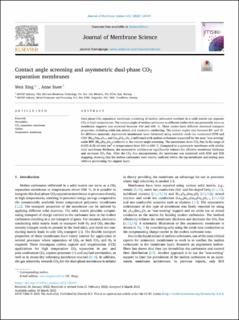| dc.contributor.author | Xing, Wen | |
| dc.contributor.author | Støre, Anne | |
| dc.date.accessioned | 2022-06-17T08:04:15Z | |
| dc.date.available | 2022-06-17T08:04:15Z | |
| dc.date.created | 2022-04-06T18:41:12Z | |
| dc.date.issued | 2022 | |
| dc.identifier.citation | Journal of Membrane Science. 2022, 652, 1-6. | en_US |
| dc.identifier.issn | 0376-7388 | |
| dc.identifier.uri | https://hdl.handle.net/11250/2999219 | |
| dc.description.abstract | Dual-phase CO2 separation membrane consisting of molten carbonates confined in a solid matrix can separate CO2 at high temperatures. The contact angle of molten carbonates to different oxides that can potentially serve as membrane supports was screened between 450 and 650 °C. These oxides have different electrical transport properties, including oxide ion, mixed, and electronic conducting. The contact angles vary between 80° and 10° for different materials. Asymmetric membranes were fabricated using wettable oxide ion conductors BTM and CGO (Bi0.8Tm0.2O1.5 and Ce0.8Gd0.2O2-δ) infiltrated with molten carbonates supported by the most "non-wetting" oxide BPR (Bi0.8Pr0.2O1.5) selected in the contact angle screening. The membranes show CO2 flux in the range of 0.035–0.35 ml/min cm2 at temperatures from 500 to 650 °C. Compared to a symmetric membrane with similar total membrane thickness, the asymmetric architecture significantly reduces the effective membrane thickness and increases CO2 flux. After the CO2 flux measurements, the membrane was examined with SEM and EDS mapping, showing that the molten carbonates were mainly confined within the top membrane and sealing area without penetrating the support layer. | en_US |
| dc.language.iso | eng | en_US |
| dc.publisher | Elsevier | en_US |
| dc.rights | Navngivelse 4.0 Internasjonal | * |
| dc.rights.uri | http://creativecommons.org/licenses/by/4.0/deed.no | * |
| dc.subject | Asymmetric membrane | en_US |
| dc.subject | Oxides | en_US |
| dc.subject | CO2 separation membrane | en_US |
| dc.subject | Wettability | en_US |
| dc.title | Contact angle screening and asymmetric dual-phase CO2 separation membranes | en_US |
| dc.title.alternative | Contact angle screening and asymmetric dual-phase CO<inf>2</inf> separation membranes | en_US |
| dc.type | Peer reviewed | en_US |
| dc.type | Journal article | en_US |
| dc.description.version | publishedVersion | en_US |
| dc.rights.holder | © 2022 The Author(s). Published by Elsevier B.V. | en_US |
| dc.source.pagenumber | 6 | en_US |
| dc.source.volume | 652 | en_US |
| dc.source.journal | Journal of Membrane Science | en_US |
| dc.identifier.doi | 10.1016/j.memsci.2022.120447 | |
| dc.identifier.cristin | 2015756 | |
| dc.relation.project | Norges forskningsråd: 272688 | en_US |
| dc.source.articlenumber | 120447 | en_US |
| cristin.ispublished | true | |
| cristin.fulltext | original | |
| cristin.qualitycode | 2 | |

